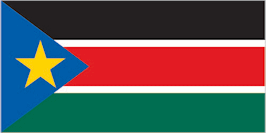South Sudan - Foreign Relations
 Sudan was the first country to recognize South Sudan's independence. The South Sudan-Sudan boundary represents the 1 January 1956 alignment, with final alignment pending negotiations and demarcation; final sovereignty status of Abyei Area pending negotiations between South Sudan and Sudan. There are periodic violent skirmishes with South Sudanese residents over water and grazing rights persist among related pastoral populations along the border with the Central African Republic. The boundary that separates Kenya and South Sudan's sovereignty is unclear in the "Ilemi Triangle," which Kenya has administered since colonial times.
Sudan was the first country to recognize South Sudan's independence. The South Sudan-Sudan boundary represents the 1 January 1956 alignment, with final alignment pending negotiations and demarcation; final sovereignty status of Abyei Area pending negotiations between South Sudan and Sudan. There are periodic violent skirmishes with South Sudanese residents over water and grazing rights persist among related pastoral populations along the border with the Central African Republic. The boundary that separates Kenya and South Sudan's sovereignty is unclear in the "Ilemi Triangle," which Kenya has administered since colonial times.
Sudan continued to support some rebel militia groups (RMGs) in South Sudan, which led to conflict and human rights abuses. The parties achieved some agreement on the citizenship of southerners in the north, and on the principles and management structure for a demilitarized border zone. However, several post-CPA issues--including oil management and the status of Abyei--remained unresolved. The parties continue to work through these issues, and the United States remains actively engaged through its support of the African Union High Level Implementation Panel (AUHIP) and its chairman, former South African President Thabo Mbeki.
Although the boundaries of the Abyei area were defined through arbitration in The Hague in July 2009, and both Sudan and South Sudan accepted the arbitration decision, issues persist and the Abyei boundary has not been demarcated. On June 29, 2011, the Government of Sudan and the Government of South Sudan signed an agreement in Addis Ababa on border security arrangements in which they agreed to establish a Safe Demilitarized Border Zone and to stand up the Joint Political and Security Mechanism before July 9. The agreement requested Ethiopian troops from the UN Interim Security Force in Abyei (UNISFA) to provide protection for international border monitors, and invited the African Union and UN to provide support for monitoring and verification within the border zone.
South Sudan became a member of the United Nations on July 14, 2011. The Security Council established the UN Mission in the Republic of South Sudan (UNMISS) in July 2011 to consolidate peace and security and to help establish conditions for development.
South Sudan was one of the highest foreign policy priorities for the U.S. Government (USG) in Africa. The United States recognized South Sudan as a sovereign, independent state on July 9, 2011. The U.S. Government is the leading international donor to South Sudan and Sudan. It contributed more than $10 billion in humanitarian, development, peacekeeping, and reconstruction assistance for the people in Sudan and eastern Chad since 2005.
The United States also was the largest provider of humanitarian assistance to Lord's Resistance Army-affected populations in South Sudan, Democratic Republic of the Congo, and Central African Republic, contributing more than $18 million in FY 2011 to support food security, humanitarian protection, health, and livelihoods initiatives for internally displaced persons, host community members, and other affected populations.
The U.S. State Department announced 02 February 2018 it would immediately enact restrictions on arms transfers to South Sudan. Paul Sutphin, the State Department’s senior adviser on Sudan and South Sudan, said the decision will “restrict the flow of lethal material into South Sudan for all parties” and is part of a series of steps “to impose consequences on those who use violence to advance a political agenda.”
The restriction was enacted through the International Traffic in Arms Regulations (ITAR), a set of U.S. laws that regulate the export and import of defense related articles and services. “This is an action we can take with our law for people who require licenses from the United States to sell arms and material,” said Sutphin.
|
NEWSLETTER
|
| Join the GlobalSecurity.org mailing list |
|
|
|

